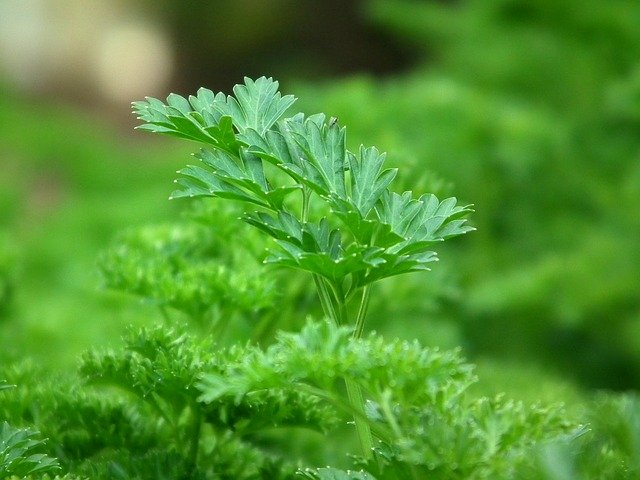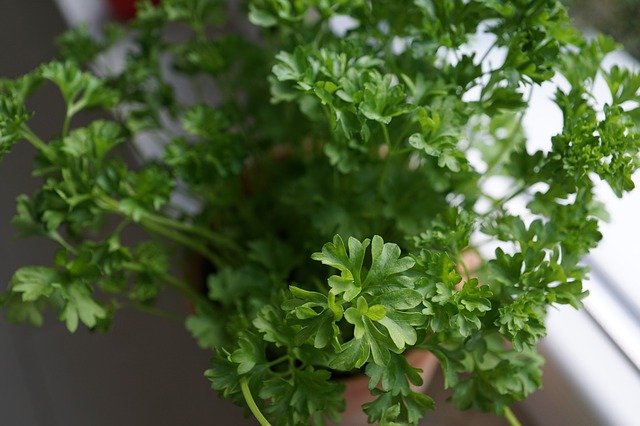
Sowing & planting parsley: Tips for a rich harvest
Parsley is a popular culinary herb. It enhances many dishes with its essential oils, which provide a great taste. In addition to these, parsley also contains many minerals such as calcium and iron and a high proportion of vitamins A, B and C. Here you will learn what to consider when planting and sowing parsley.
This article contains:
- Planting parsley: how to sow & plant
- The right location for parsley
- Planting parsley: Good and bad neighbors
- Parsley in mixed cultivation: examples for your planting plan
- Curly or flat-leaf parsley?
- The right care for parsley
- Harvesting parsley correctly: A guide
- Frequently asked questions about sowing and planting parsley
Quick Overview
Planting and sowing parsley
- Direct sowing from the beginning of April
- Planting depth: 1-2 cm
- Sowing depth: 0.5 cm
- Row spacing: 25 cm
- Location: semi-shady to sunny
- Soil: humus-rich and water-permeable
Caring for parsley properly
- sufficient moisture
- No waterlogging
- Keep the soil free of weeds
Harvesting parsley
- from the outside to the inside, so that the parsley plant can sprout again
- can be harvested several times until flowering, as parsley grows biennially
Planting parsley: how to sow & plant
You can sow parsley directly outdoors from the beginning of April and then harvest it in the summer to fall. You can even sow them indoors from January. However, early sowings tend to flower in summer. Late sowings, on the other hand, can even overwinter in the bed, as parsley is hardy down to -8 degrees. You can find out how to overwinter and propagate parsley in this article.
The seeds are sown 1 to 2 centimetres deep and approx. 25 cm apart in rows. However, sowing parsley requires a little patience, as it germinates very irregularly and takes a long time to germinate. It can take up to three weeks for the small seeds to germinate. Until the seeds emerge, the area must be well watered and regularly cleared of weeds.
However, you can also buy parsley in pots in many markets. At home, you should then repot or plant them as quickly as possible, as the plants are usually already well rooted. To do this, carefully divide them once or twice and then plant them in a larger pot or in a suitable place in the garden. Plant the seedlings a little deeper into the soil than before in the pot.

The right location for parsley
The location should be sunny to semi-shady, with parsley preferring a sunny location. The soil should be loose and humus-rich. Parsley is not fussy about its location, it just needs to be free of waterlogging and have enough nutrients. For a good start, you can add some compost to the parsley planting hole.
Planting parsley: Good and bad neighbors
The right neighborhood (mixed cultivation) and crop rotation also play a role in successful cultivation. Parsley should not be sown in the same area after other umbellifers. As neighbors, care should be taken not to plant crops too close to each other that require a lot of space. In addition, plants of the same family are often not good neighbors.
| Good neighbors | Bad neighbors | ||
|---|---|---|---|
| Arugula / Rocket | Cucumber | Beetroot | Lettuce |
| Asparagus | Garlic | Borage | Lovage |
| Basil | Leeks | Carrots | Mint |
| Beans | Marjoram | Cellery | Nasturtium |
| Broccoli | Onion & Spring Onion | Chervil | Parnship |
| Chamomile | Pepper / Paprika | Dill | Root parsley |
| Chili | Savory | Fennel | Turnip-rooted chervil |
| Collard greens | Strawberry | Topinambur | |
| Common marigold | Thyme | Lavender |
Parsley in mixed cultivation: examples for your planting plan
For inspiration, you can find bed plans for mixed cultivation with parsley here. You will find ideas for the balcony, a herb spiral or your greenhouse.
Curly or flat-leaf parsley?
A distinction is made between smooth and curly leaf parsley. The smooth-leaved varieties usually have larger leaves and are more intense in flavor than their curly counterparts. They are therefore very suitable as a spice, finely chopped in food. The curly-leafed varieties, on the other hand, are somewhat milder. On the other hand, they keep fresh for longer and are great as a decoration on the plate. Curly parsley can also cope a little better with dryness in the bed than flat-leaf parsley.
The right care for parsley
The herb is actually quite undemanding when it comes to care. It needs plenty of moisture to grow, but you should avoid waterlogging. The best way to test how much you need to water is to do the finger test. To do this, press your thumb into the soil, which should feel neither boggy nor very dry. At the beginning after sowing, it also needs a little more care. The seeds like warm and moist soil for germination. To be able to harvest throughout the summer, always loosen the soil a little and keep it weed-free. The herb no longer needs fertilizer.
Harvesting parsley correctly: A guide
When your parsley plants are strong enough, you can start harvesting. You should only cut off the outer leaves, as parsley grows as a rosette. New leaves continue to sprout from the heart in the middle. As it is a biennial, you can leave it standing over the winter and continue harvesting it until it flowers the following year.
If you have any questions or comments, please write to us at [email protected].
Want to get helpful gardening tips all year round and plan your own beds in the best possible way? Then register here or download the Fryd app for Android or iOS.
Fryd - Your digital bed planner
Cover picture by AllNikArt on Pixabay.

Marie
Marie studied agricultural science at the University of Hohenheim. Her main focus is on ecological agriculture and permaculture. She writes articles for Fryd to educate people about ecological interrelationships and alternatives to current land use. Our current economic systems, especially in agriculture, have numerous negative effects on nature and destabilize our ecosystems. We need a great diversity in our gardens and beds again to counteract the extinction of species. Every gardener can contribute to creating and maintaining habitats and food for a wide variety of creatures. With her articles, she would like to pass on her experience in dealing with natural systems and give people the opportunity to contribute to a stable ecosystem and thus also to securing our livelihood.
Learn moreCurrent topics in the community

Liked 3 times
A small interim result of my #chili breeding
Show 1 answer
Brief update on the #nudibranchs 🐌 I've been collecting them every day now. And... I have the feeling that the damage hasn't gotten any worse. Also thanks to my new favorite snails. #tiger snails! Here's my biggest and smallest specimen. I counted a total of 8 today! 😍 YES!

Liked 2 times
Hello dear gardening friends, I have another question: my #tomatoes really don't have it easy. First of all, the severe frost with bringing them back in and making them go yellow. Then they were really stressed and curled up their top leaves. And NOW I have an insane amount of thirps on every damn plant. The poor #tomatoes are slowly starting to turn yellow from the bottom, i.e. the leaves. I've now sprayed the plants with neem, because thank goodness it's there. But according to the instructions, I'm only allowed to use it every 7 days. But it's a real plague at the moment and I'm currently looking for other solutions or combinations. I made a garlic decoction 2 days ago, which I will finish off tomorrow with soft soap and cayenne pepper. I also read that lacewing larvae help really well. But they won't arrive until Tuesday. So now to the question: if I use beneficial insects, can I also make a garlic decoction like this in combination with beneficial insects or will they die on me? 🙈 I'm really not having any luck today. I think all the pests are coming directly from the plum tree, which is also struggling with all sorts of things this year. I've heard that @zwilling or @Sonnenkind could help me. I would be very grateful ♥️
Show 1 answerFAQ
When to sow and plant parsley?
You can sow parsley directly outdoors from the beginning of April until the fall, as it is hardy. You can start preplanting it in January and plant it outdoors from March/April.
How long does parsley take to germinate?
Parsley takes quite a long time to germinate. The first seeds germinate after about three weeks. You therefore need to be patient when sowing parsley.
Parsley grows best in a sunny spot with humus-rich soil. If you only have a partially shaded spot, the parsley plant will also tolerate this. You should avoid waterlogging.
Parsley grows back and can be harvested several times. However, you should always leave the heart standing when harvesting and only harvest leaves from the outside.
What is the difference between flat-leaf and curly parsley?
These varieties differ in their leaf shape. Smooth-leaved varieties usually have larger and more aromatic leaves. Curly parsley, on the other hand, tastes milder and has a longer shelf life.
